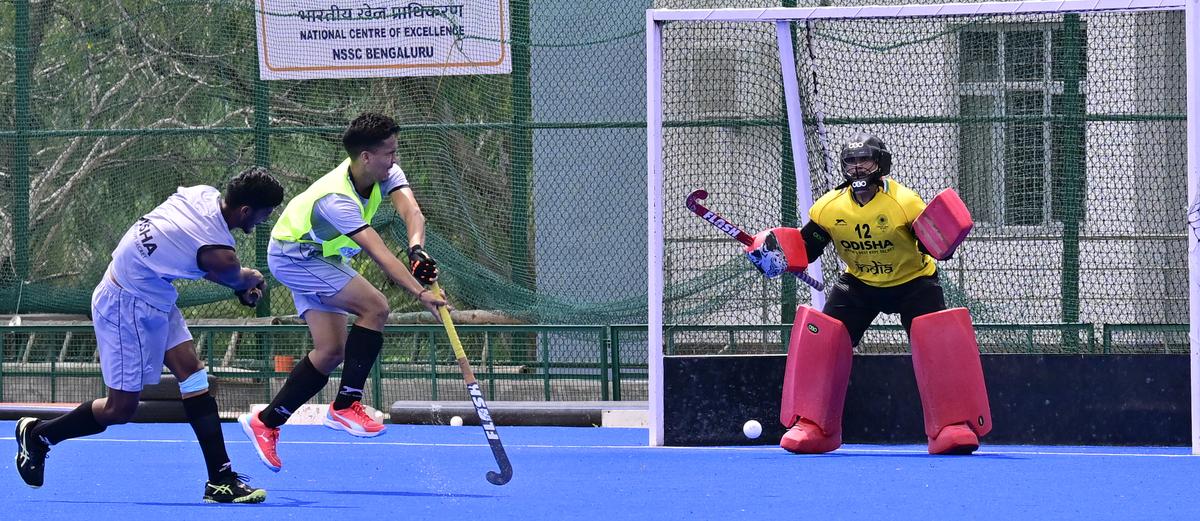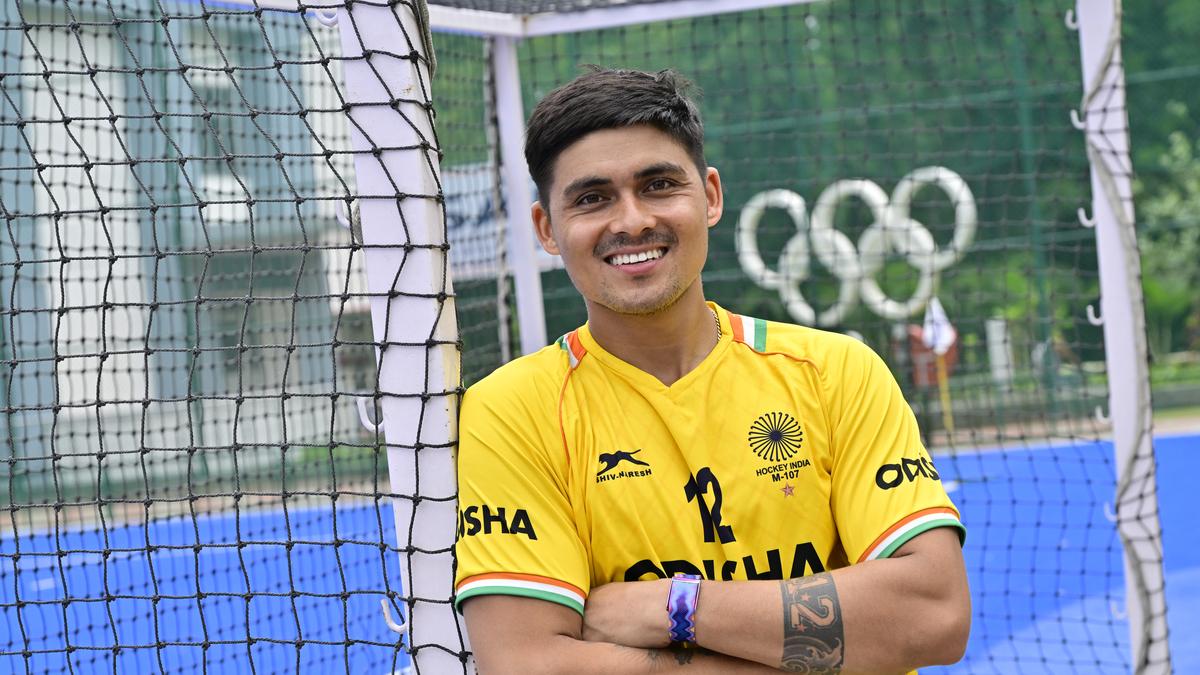Brick by brick, Krishan Pathak set to become the new Wall in Blue of Indian hockey
A familiar face was missing from the Indian men’s hockey team’s training session as coach Craig Fulton put his squad through their paces at the Sports Authority of India’s (SAI) National Centre of Excellence in Bengaluru.
After serving as India’s goalkeeper for over two decades, P.R. Sreejesh retired following his second consecutive Olympic bronze medal at the Paris 2024 Olympics.
The absence of his commanding voice, often heard directing defenders, was palpable as the sound of hockey sticks slicing through the turf and clashing echoed around the training complex. Stepping into the shoes of a legend like Sreejesh is a daunting task. His legacy extends far beyond his impressive 336 caps and exceptional on-field prowess. As a revered senior leader, he has left an indelible mark on the team. Now, Krishan Bahadur Pathak faces the challenge of filling this void. Pathak, and his compatriot Suraj Karkera, are the two goalkeepers selected in the Indian squad for the Asian Champions Trophy, which gets underway from September 8.
Pathak, a 26-year-old from Kapurthala, Punjab, was born to parents who migrated from Nepal in search of a better life. He credits his success to the support of his family and their adopted state.
“We were four siblings, and we didn’t have much money in Nepal. It was very difficult to manage, so my parents moved to Punjab, where I was born,” Pathak reminisced during a conversation with Sportstar.
“Punjab played a big role in shaping who I am today. If I had stayed in Nepal, my story would have been different. From what I’ve seen — all the struggles my parents went through, the jobs they took, and the small things they provided for me — it’s all very motivating,” he shared. Pathak’s journey with hockey began when he joined his friends to play at the Rail Coach Factory (RCF) in Kapurthala.
“The coach at RCF told me they didn’t have a goalkeeper, and that’s where my journey as a keeper started. After that, I was selected for the Surjeet Hockey Academy in Punjab,” he said.

Warming up: Krishan Pathak in action during Indian men’s hockey team’s training session at the SAI National Centre of Excellence in Bengaluru.
| Photo Credit:
K MURALI KUMAR
Warming up: Krishan Pathak in action during Indian men’s hockey team’s training session at the SAI National Centre of Excellence in Bengaluru.
| Photo Credit:
K MURALI KUMAR
Succession plan
The men’s hockey team has navigated the delicate transition from a legendary figure to a new custodian with remarkable ease. Pathak, with 125 caps spanning six years, has had the privilege of learning from the best, ensuring continuity and stability within the group.
“When you’ve played 125 matches for your country, replacing someone or stepping into their role isn’t a problem. You gain a different level of confidence after that. You’ve played in major tournaments like the World Cup, the Asian Games, and the Asian Champions Trophy,” Pathak said.
He continued, “If I were in a different situation, where I hadn’t played many games, it would have been very difficult. If a senior player is unavailable and you suddenly have to step in, the team needs to take responsibility because you lack the necessary experience.”
Much credit goes to former coach Graham Reid, who rotated Pathak and Sreejesh across matches and even as rolling substitutions within games, with each playing two quarters per game.
Pathak also advocates for the same approach to be followed in the future. “Junior goalkeepers need to play games to build their confidence. Otherwise, they won’t know what situations they’ll face or what kind of pressure they’ll be under.”
Throughout Pathak’s career, Sreejesh has been a constant source of inspiration, mentoring him closely. Their relationship, which began during the 2016 Junior World Cup in Uttar Pradesh, where India won gold, has evolved from that of mentor and mentee to close friends.
“When we played the Junior World Cup in 2016, he joined our team in Lucknow. Having a senior player with you helps you learn different things. You build confidence and become more aware of your mistakes,” Pathak reflected.
He added, “It’s good to have a friendship with someone like that. We used to discuss our mistakes, which was beneficial for both of us.”
Prudent call: Former coach Graham Reid’s strategy of rotating Krishan Pathak and P.R. Sreejesh, with each playing two quarters per game, deserves credit for Pathak’s seamless transition.
| Photo Credit:
BISWARANJAN ROUT
Prudent call: Former coach Graham Reid’s strategy of rotating Krishan Pathak and P.R. Sreejesh, with each playing two quarters per game, deserves credit for Pathak’s seamless transition.
| Photo Credit:
BISWARANJAN ROUT
Big shoes to fill
On the field, Pathak’s biggest challenge will be to replicate Sreejesh’s dominance in goal. As modern hockey increasingly relies on Penalty Corners (PCs) to score, teams are continually developing new strategies to capitalise on these opportunities.
At Paris 2024, India defended PCs exceptionally well, with Sreejesh earning widespread praise for his crucial saves, particularly during the quarterfinal against Great Britain when the team was reduced to 10 men. Pathak will face similar tests in upcoming tournaments, but he remains confident in his ability to rise to the occasion, supported by a rock-solid PC defensive unit.
“We prepare extensively for the penalty corners, collaborating with the analysts to understand the variations employed by different teams. This preparation is invaluable during matches,” he said. “We have Amit Rohidas, one of the best first runners, along with Manpreet, Harmanpreet, and Jarmanpreet guarding the goalpost. Our penalty corner defence deserves a lot of credit too.”
“When you have such a strong defensive unit, it instills confidence and trust in the team. At the Olympics, out of 52 penalty corners, we conceded only four or five goals, including straight flicks and rebounds. That’s an incredible achievement,” the goalkeeper added. Off the field, Pathak has embraced the joy of fatherhood with his six-month-old son.
“I feel really good because when I see him, especially during training breaks when I call and see his smile, it gives me a special feeling and motivation,” he said.
“There are so many things happening around you. You have to take care of your family and the baby. It’s a lot of fun. I don’t feel any extra pressure, and I’m thoroughly enjoying this phase of my life,” he shared. Despite his best efforts over the years, including winning the Baljit Singh Award For Goalkeeper Of The Year twice (2019, 2022), an Olympic medal still eludes him. Pathak travelled with the team as a reserve goalkeeper for both Tokyo 2020 and Paris 2024, but Olympic rules meant that only members of the main squad (18 in Tokyo and 16 in Paris) received medals.
“There is some sorrow. I’ve been part of the team for over six years, but there’s also pride in being part of this squad,” he said.
“When I returned home this time, my wife told me, ‘The team won bronze the two times you travelled with them; maybe next time when you play, the colour will be gold.’ Her words give me added motivation.”
“Jo maine nahi paaya…usey paana hai (What I haven’t achieved yet… I must achieve).”



